Climatologist talks El Nino, the Blob, climate change
Published 4:42 am Wednesday, September 19, 2018

- Nick Bond, Washington state climatologist, spoke about ocean conditions and predictions for the Columbia Forum speaker series.
Imagine a hangover that lasts for years.
In 2013 and 2014, a mass of warm water formed off the West Coast. The Blob, so named by Washington State Climatologist Nick Bond, persisted through 2015 and 2016 after a massive El Nino event hit and kept it alive. Temperatures inside the Blob were recorded at nearly 3 degrees C warmer than normal.
These were years marked by drought, sea bird and salmon die-offs, marine mammal starvation, extensive harmful algal blooms, razor clam and Dungeness fishery closures and beautiful warm summer days for North Coast residents.
The effects of each single event have bled into the following year. This year, the Blob might be gone and ocean conditions may have returned to something closer to normal, but Oregon and Washington state are still nursing a hangover.
That hangover is particularly apparent in low salmon returns to the Columbia River this fall, Bond said in a talk titled “The Blob, El Nino and Climate Change: Looking for a Hot Time in the Pacific Northwest?” He kicked off this season’s Columbia Forum speaker series Tuesday night.
Oregon and Washington state fishery managers closed the river to all salmon fishing last week due to salmon returns that were well below preseason predictions. Besides upper Columbia sockeye, most runs are now expected to come in at 30 percent or less of the preseason forecast, said Tucker Jones, Columbia River program manager for Oregon.
The salmon returning to the Columbia River this year are fish that entered the ocean during the Blob years, into conditions that were not expected to be friendly to their survival, Bond said.
And now there is the possibility of a weak to moderate El Nino occurring this year, which, said Bond, “is not great news for some parts of the marine ecosystem.”
Bond’s work is in predictions and forecasts, a role that becomes more complex when confronted with anomalous conditions like the Blob and conditions that are expected to become longer-lasting with climate change.
He is also a senior research scientist with the University of Washington’s Joint Institute for the Study of Atmosphere and Ocean, and calls the Blob and the years that followed a sort of “dress rehearsal for climate change” — a taste of what might become the West Coast’s new normal. As climate change becomes more and more of a reality, he and others in the field are trying to develop ways to predict ocean conditions further out than they have before.
People already use climate models that look at conditions in the atmosphere and ocean to predict seasonal weather conditions. Now, Bond said, “We’re starting to use them for seasonal ocean conditions in kind of the same way so marine interests have a heads up about what’s happening.”
Armed with these kinds of forecasts, the fishing industry and fishery managers could make decisions in very different ways, he said.
But: “If you think we’re at a stage where we can say, ‘Oh yeah, you know, come March 2019 it’s going to be kind of warm out there and we’re not going to have the right kind of forage conditions for salmon’… Can we do that?”
Kind of yes. Kind of no.
Even harder to predict are biological responses to shifting ocean conditions.
As the long hangover continues, Bond and other researchers are still looking into what the ocean conditions during the Blob and harmful algal bloom years meant for the ocean’s animals and plants.
“What we’re waiting to find out is whether this event kind of reorganized the marine communities or how fast populations will recover,” Bond said afterwards.
“Will there be some wholesale changes in the ecosystem that will persist for a long time? We’ve seen in the past when there’s been environmental change there has been a whole different mix of species,” he added.
“So will this be an example or will it be, in a couple years, just a distant nightmare?”









